ARS ELECTRONICA ARCHIVE - PRIX
Der Prix Ars Electronica Showcase ist eine Sammlung, innerhalb derer die Einreichungen der KünstlerInnen zum Prix seit 1987 durchsucht und gesichtet werden können. Zu den Gewinnerprojekten liegen umfangreiche Informationen und audiovisuelle Medien vor. ALLE weiteren Einreichungen sind mit den Basisdaten in Listenform recherchierbar.
Vectorial Elevation, Relational Architecture #4
Rafael Lozano-Hemmer
5232Original: ENT_IA0025_AEC_PRX_2000_VectorialElevation.avi | 720 * 576px | 17m 38s | 3.7 GB
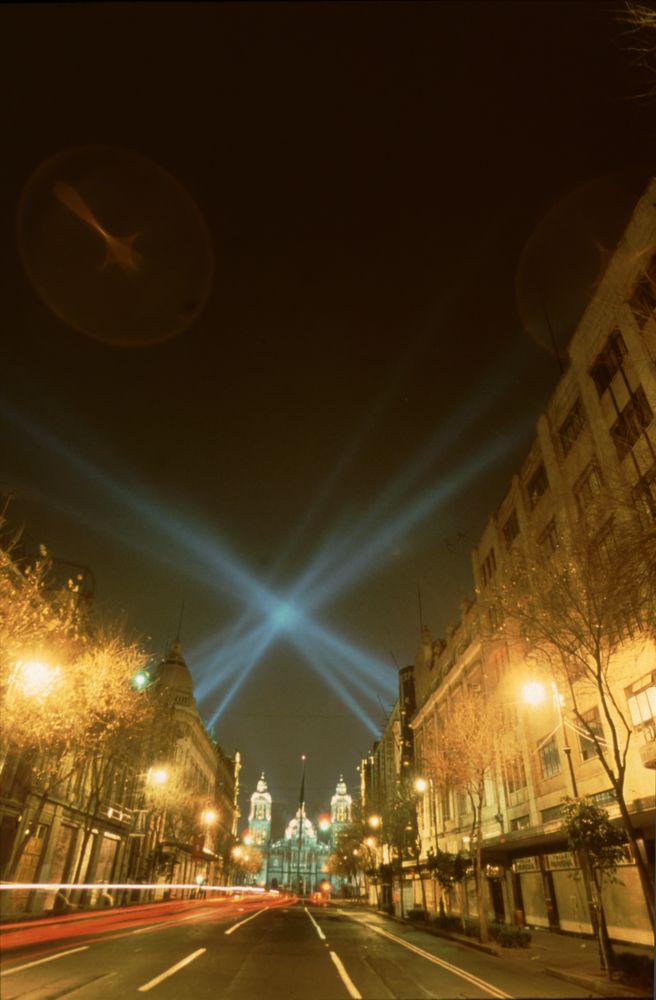
Original: ENT_IA0025_AEC_PRX_2000_vectorial-elevation_1338695.tif | 1064 * 1622px | 5.0 MB
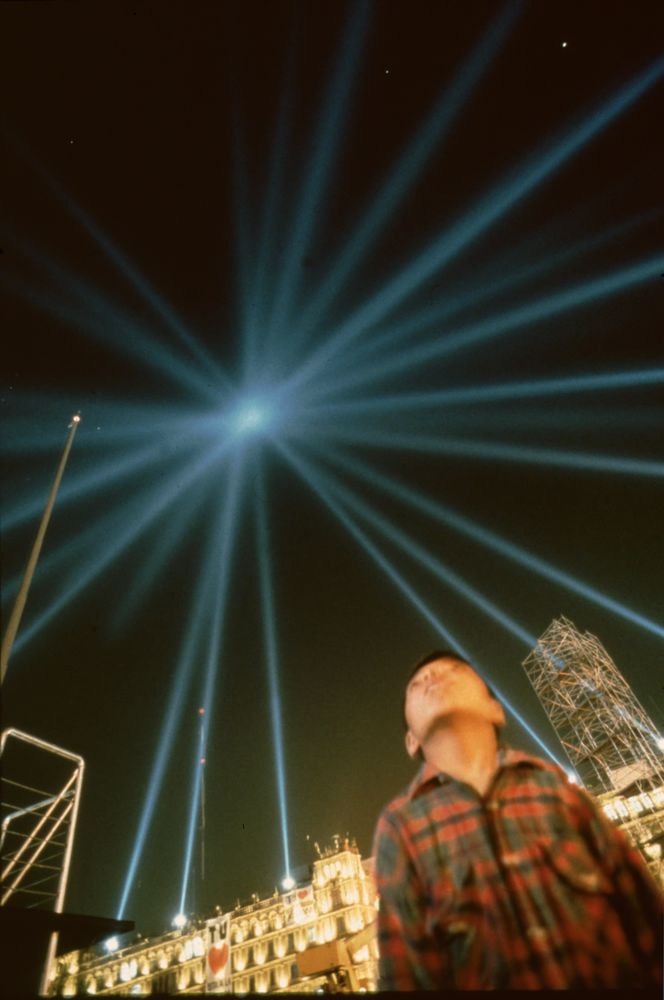
Original: ENT_IA0025_AEC_PRX_2000_vectorial-elevation_1338697.tif | 1075 * 1618px | 5.0 MB
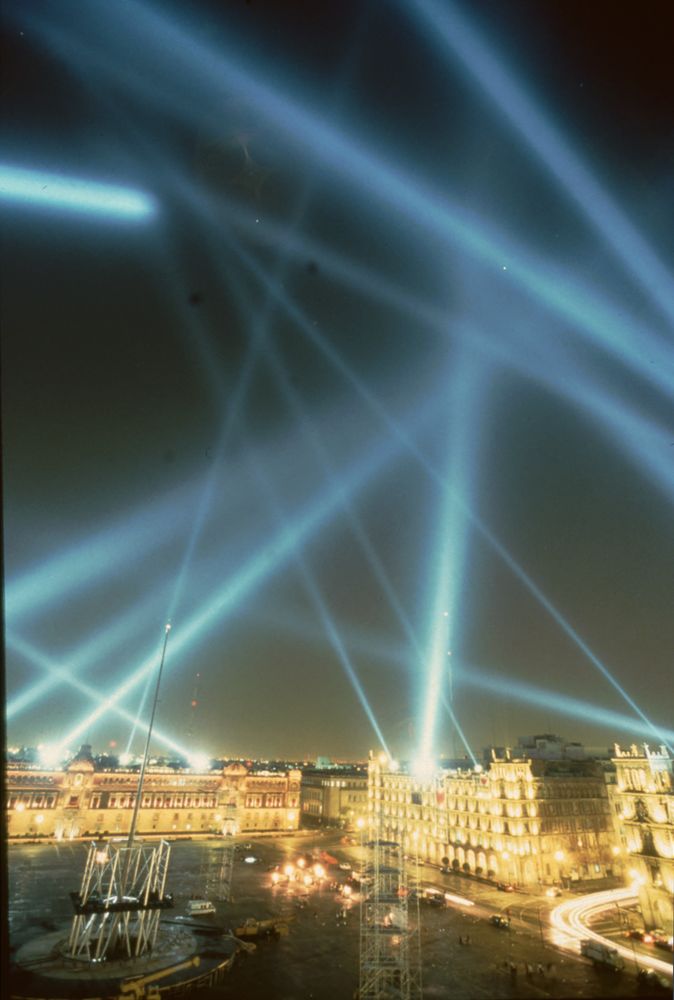
Original: ENT_IA0025_AEC_PRX_2000_vectorial-elevation_1338699.tif | 1079 * 1601px | 5.0 MB
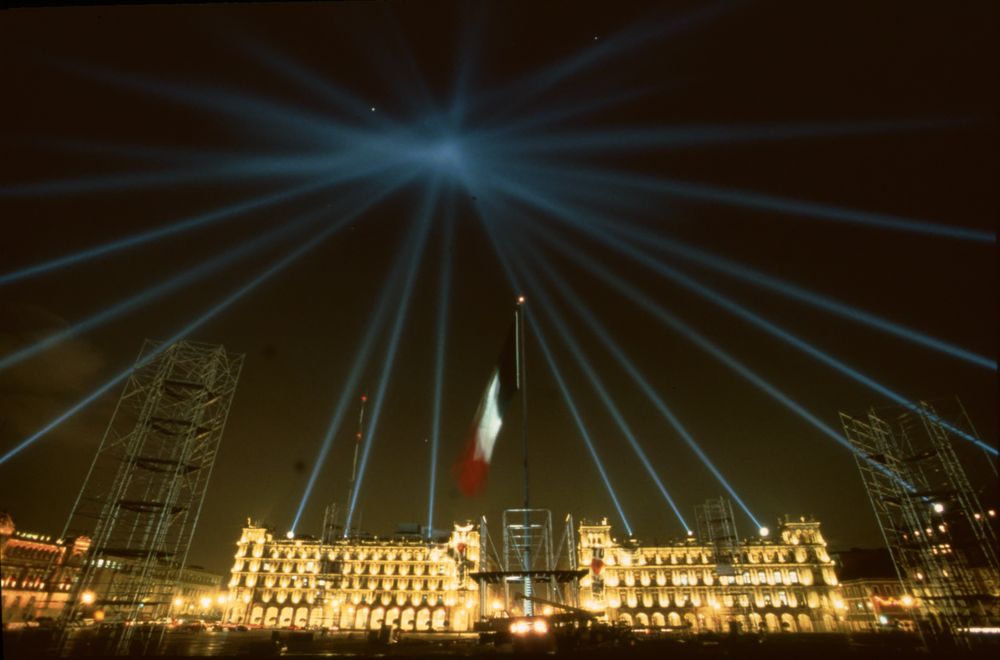
Original: ENT_IA0025_AEC_PRX_2000_vectorial-elevation_1338703.tif | 1630 * 1076px | 5.0 MB
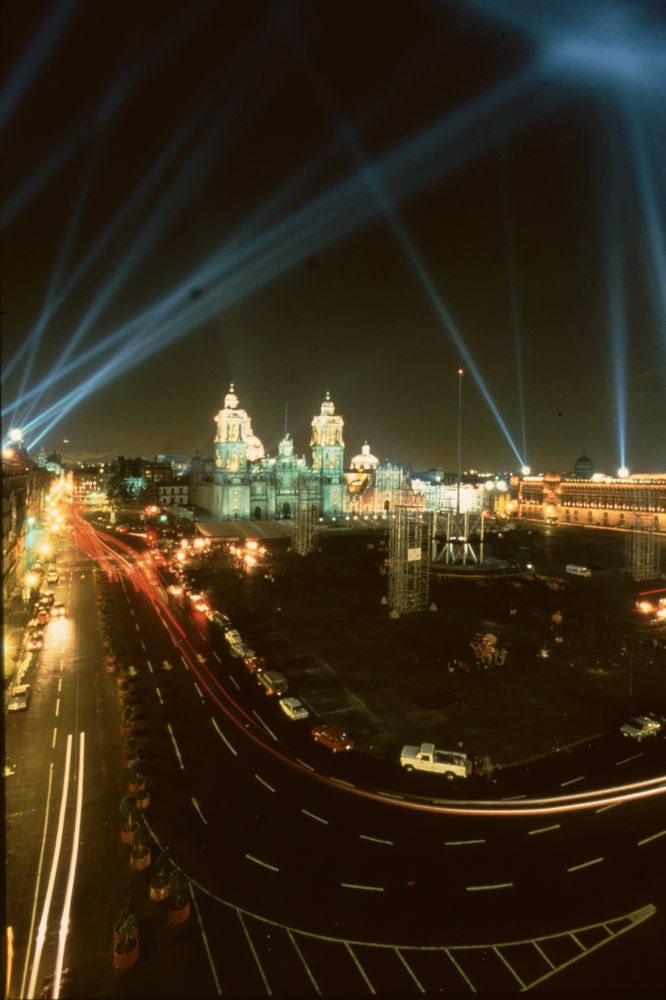
Original: ENT_IA0025_AEC_PRX_2000_vectorial-elevation_1338705.tif | 1073 * 1610px | 5.0 MB
Raffael Lozano-Hemmer's "Vectorial Elevation, Relational Architecture #4" ist als öffentliches Kunstwerd interessant, als ausgefeiltes und dennoch simples Userinterface und als höchst erfolgreiches Beispiel für Kollaboration. Interessant war auch, wie es sich die faschistischen Lichtspiel-Themen aneignete und sie in einem für alle zugänglichen öffentlichen künstlerischen Ausdruck umsetzte...
Vectorial Elevation war eine groß angelegte interaktive Installation zur visuellen Umgestaltung des Zentrums der Altstadt von Mexico City mit Hilfe von robotischen, über das Internet gesteuerten Suchscheinwerfern.
Besucher des Projekts, die sich über einloggten, konnten vergängliche Lichtskulpturen über dem Zócalo, dem Nationalpalast, dem Rathaus, der Kathedrale und den Ruinen des großen Aztekentempels schaffen. Diese Lichtskulpturen – die mittels 18 rund um den Zócalo angeordneten Xenon-Scheinwerfern gestaltet wurden – waren noch aus einer Entfernung von 15 Kilometern erkennbar und wurden in der Reihenfolge, in der sie über das Internet herein kamen, sequenziell abgearbeitet.
Die Website bestand aus einem 3D-Java-Interface, das es den Mitwirkenden ermöglichte, ein vektorielles Design über die Innenstadt zu legen und es aus fast jedem Blickwinkel zu betrachten. Sobald der Projektserver in Mexico einen Beitrag empfing, wurde dieser nummeriert und in eine Warteschlange eingereiht. Alle sechs Sekunden richteten sich die Scheinwerfer automatisch aus und mittels dreier Webcams wurden Aufnahmen zur Dokumentation des Designs der einzelnen Mitwirkenden geschossen. Für jeden Teilnehmer wurde eine Archivseite mit Kommentaren, Informationen und elektronisch gekennzeichneten Fotos des jeweiligen Designs angelegt. War diese aktive Webseite fertig gestellt, wurde der Teilnehmer automatisch über E-Mail benachrichtigt.
Vectorial Elevation wurde von Teilnehmern aus über 50 Ländern und aus allen Regionen Mexikos besucht. Um den Zugang im Land selbst zu erleichtern, wurden kostenlose Terminals in öffentlichen Bibliotheken und Museen im ganzen Land aufgestellt.
Die monumentale Größe des Zócalo lässt die Dimension des Menschen unbedeutend werden – eine Beobachtung, die mexikanische Wissenschaftler als Ausdruck einer rigiden, monolithischen und gleichmacherischen Umgebung interpretierten. Auch die Suchscheinwerfer als solche wurden mit autoritären Regimes in Zusammenhang gebracht – zum Teil deswegen, weil sie ihre Vorgänger in der militärischen Luftabwehr haben. Und nicht zuletzt ist ja auch das Internet selbst ein Erbe des Wunsches des Militärs nach Steuerung und Überwachung dezentralisierter Operationen.
Dadurch, dass Vectorial Elevation die Mitwirkenden zu einem integrierten Bestandteil des Kunstwerkes machte, sollte eine neue kreative Beziehung zwischen Steuerungs- und Überwachungstechnologie, zwischen urbanen Landschaften und dem lokalen wie dem remoten Publikum hergestellt werden – ein Versuch, den post-geografischen Raum des Internet mit der spezifischen städtischen Wirklichkeit der bevölkerungsreichsten Stadt der Welt zu verknüpfen.
Vectorial Elevation war eine groß angelegte interaktive Installation zur visuellen Umgestaltung des Zentrums der Altstadt von Mexico City mit Hilfe von robotischen, über das Internet gesteuerten Suchscheinwerfern.
Besucher des Projekts, die sich über einloggten, konnten vergängliche Lichtskulpturen über dem Zócalo, dem Nationalpalast, dem Rathaus, der Kathedrale und den Ruinen des großen Aztekentempels schaffen. Diese Lichtskulpturen – die mittels 18 rund um den Zócalo angeordneten Xenon-Scheinwerfern gestaltet wurden – waren noch aus einer Entfernung von 15 Kilometern erkennbar und wurden in der Reihenfolge, in der sie über das Internet herein kamen, sequenziell abgearbeitet.
Die Website bestand aus einem 3D-Java-Interface, das es den Mitwirkenden ermöglichte, ein vektorielles Design über die Innenstadt zu legen und es aus fast jedem Blickwinkel zu betrachten. Sobald der Projektserver in Mexico einen Beitrag empfing, wurde dieser nummeriert und in eine Warteschlange eingereiht. Alle sechs Sekunden richteten sich die Scheinwerfer automatisch aus und mittels dreier Webcams wurden Aufnahmen zur Dokumentation des Designs der einzelnen Mitwirkenden geschossen. Für jeden Teilnehmer wurde eine Archivseite mit Kommentaren, Informationen und elektronisch gekennzeichneten Fotos des jeweiligen Designs angelegt. War diese aktive Webseite fertig gestellt, wurde der Teilnehmer automatisch über E-Mail benachrichtigt.
Vectorial Elevation wurde von Teilnehmern aus über 50 Ländern und aus allen Regionen Mexikos besucht. Um den Zugang im Land selbst zu erleichtern, wurden kostenlose Terminals in öffentlichen Bibliotheken und Museen im ganzen Land aufgestellt.
Die monumentale Größe des Zócalo lässt die Dimension des Menschen unbedeutend werden – eine Beobachtung, die mexikanische Wissenschaftler als Ausdruck einer rigiden, monolithischen und gleichmacherischen Umgebung interpretierten. Auch die Suchscheinwerfer als solche wurden mit autoritären Regimes in Zusammenhang gebracht – zum Teil deswegen, weil sie ihre Vorgänger in der militärischen Luftabwehr haben. Und nicht zuletzt ist ja auch das Internet selbst ein Erbe des Wunsches des Militärs nach Steuerung und Überwachung dezentralisierter Operationen.
Dadurch, dass Vectorial Elevation die Mitwirkenden zu einem integrierten Bestandteil des Kunstwerkes machte, sollte eine neue kreative Beziehung zwischen Steuerungs- und Überwachungstechnologie, zwischen urbanen Landschaften und dem lokalen wie dem remoten Publikum hergestellt werden – ein Versuch, den post-geografischen Raum des Internet mit der spezifischen städtischen Wirklichkeit der bevölkerungsreichsten Stadt der Welt zu verknüpfen.
Rafael Lozano-Hemmer: Concept, direction, interface.
Relational Art (E/CDN)
Will Bauer: Project manager.
Conroy Badger: Lead programmerjava engine, DA/IX control, Shout3D applet.
Crystal Jorundson: Webcam watermarking, differential GPS, vrmljpeg generation.
Dragos Ruiu: Server, security and Streaming video programming.
Kimihiko Sato: Streaming video dient, servlets.
Emilio López-Galiacho: 3D Modelling, vrml export.
Paul Pelletier: Gase and MSD programming
Kelly Myers, Ana Parga, Susie Ramsay, Therese Gaetz, Rob Lake, Greg Bodnar: Production assistance
Conaculta (Mexico)
Rafael Tovar: President
Ignacio Toscano: Coordinatorfor the Millennium celebrations
Juan Ramón Ayala: Production manager
Alicia Martinez, Lilia Vera, Fernanda Garfias, Lourdes Melgoza, Guillermina Ochoa, Ernesto Betancourt, Felipe Leal, Jorge Bracho, Ariel Rojo: Production assistants
Rac Producciones, Grupo CIE (Mexico)
Guadalupe deAnda: Production Manager
Luis J. Vargas, Mario Torres, Jose Antonio Barona, Luis Perez, Miguel Angel Villa, Armando Sdnchez, Arturo Mendoza, Alejandro Echenigue: Production team
Syncrolite (USA)
Jorge Gailegos: Lead Technician
Alberto Meza, Renato de! CastilloJejfMoss, Sergio Martinez, Mauricio Martinez, Omar Rivas, Raül Rios, Roberto Diaz: Technicians
Jerry Woods, Harold McLallen: Clifford Power
Telmex, Centec (Mexico)
Jose Manuel Cortes: Director
Ricardo Medina: Development Manager
Jorge Huesca Salas, Alejandro Fuentes, Hector Leon: Centec engineering
Ricardo Rodriguez Aguilar: Sistemas support
Relational Art (E/CDN)
Will Bauer: Project manager.
Conroy Badger: Lead programmerjava engine, DA/IX control, Shout3D applet.
Crystal Jorundson: Webcam watermarking, differential GPS, vrmljpeg generation.
Dragos Ruiu: Server, security and Streaming video programming.
Kimihiko Sato: Streaming video dient, servlets.
Emilio López-Galiacho: 3D Modelling, vrml export.
Paul Pelletier: Gase and MSD programming
Kelly Myers, Ana Parga, Susie Ramsay, Therese Gaetz, Rob Lake, Greg Bodnar: Production assistance
Conaculta (Mexico)
Rafael Tovar: President
Ignacio Toscano: Coordinatorfor the Millennium celebrations
Juan Ramón Ayala: Production manager
Alicia Martinez, Lilia Vera, Fernanda Garfias, Lourdes Melgoza, Guillermina Ochoa, Ernesto Betancourt, Felipe Leal, Jorge Bracho, Ariel Rojo: Production assistants
Rac Producciones, Grupo CIE (Mexico)
Guadalupe deAnda: Production Manager
Luis J. Vargas, Mario Torres, Jose Antonio Barona, Luis Perez, Miguel Angel Villa, Armando Sdnchez, Arturo Mendoza, Alejandro Echenigue: Production team
Syncrolite (USA)
Jorge Gailegos: Lead Technician
Alberto Meza, Renato de! CastilloJejfMoss, Sergio Martinez, Mauricio Martinez, Omar Rivas, Raül Rios, Roberto Diaz: Technicians
Jerry Woods, Harold McLallen: Clifford Power
Telmex, Centec (Mexico)
Jose Manuel Cortes: Director
Ricardo Medina: Development Manager
Jorge Huesca Salas, Alejandro Fuentes, Hector Leon: Centec engineering
Ricardo Rodriguez Aguilar: Sistemas support
Rafael Lozano-Hemmer (MEX/CDN) ist Medienkünstler und lebt derzeit in Madrid. Seine Installations- und Performancewerke umfassen Telepräsenz, Netzwerke sowie Großereignisse im öffentlichen Raum. Seine Arbeiten waren in über einem Dutzend Länder zu sehen, zuletzt in Österreich, Mexiko, Deutschland und Schweden. Will Bauer ist der Erfinder des "Gesture and Media System" (GAMS), eines kabellosen 3D-Mediensteuerungstools und Inhaber zahlreicher Patente in verschiedenen Bereichen der Technologie. Er hat seine Arbeiten bei vielen Festivals präsentiert, darunter bei Cyberconf, Ars Electronica, SIGGRAPH, dem Fringe Theatre Festival und ARCO.


